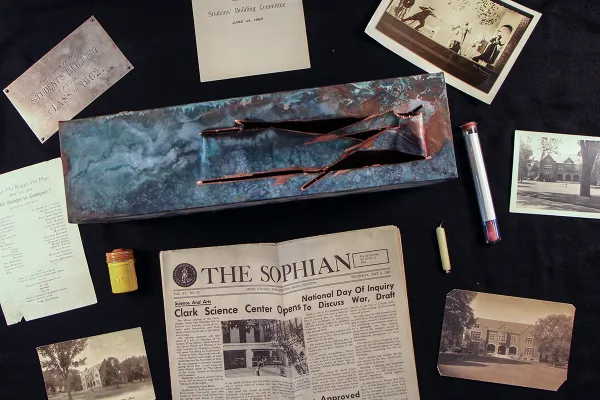A New Time Capsule Will Be Planted Soon
Campus Life

Published March 27, 2014
1967 was the year the musical Hair opened off-Broadway, Thurgood Marshall was sworn in as the first African American Supreme Court justice and Aretha Franklin recorded the hit song “Respect.”
It was also the year that a time capsule, unearthed in 2013, was planted in the courtyard between Sabin-Reed/Burton and McConnell halls as part of the dedication of the newly constructed Clark Science Center. Inspired by that discovery, faculty and staff are preparing to embed a new capsule during the ongoing renovations at the Smith College Conference Center.
According to Conference Center Manager Addison MacDonald, the new capsule will be planted this spring and will include artifacts from a broad cross-section of campus life, including materials related to the inauguration of President Kathleen McCartney and memorabilia from Dining Services, a department closely connected with the history of the center, especially when it housed the Faculty Club.
“It’s going to be a mix of images and memorabilia from a certain day and age,” MacDonald says, “and I hope it raises a lot of questions. This is an opportunity for us to speak directly to the Smith community many years from now and, as in any conversation, our meanings don’t all have to be obvious. There will definitely be some mysteries to uncover for those who stumble across it.”
According to College Archivist Nanci Young, artifacts discovered in the older capsule included a copy of The Sophian dated May 4, 1967, with the headline “Clark Science Center Opens,” a roll of film in a canister (it has not been developed), the program for an Alpha-Phi Kappa Psi play titled “She Stoops to Conquer,” a silver four-leaf clover pendant and a candle burned at both ends.
The current time-capsule project was initiated by Susan Van Dyne, professor of the study of women and gender and director of the archives concentration, who noticed the construction at 51 College Lane and proposed the idea to MacDonald. Since then, the two have been working with Dean of Religious Life Jennifer Walters to collect items for a container they expect will remain undisturbed for at least 75 years.
In her classes, Van Dyne says, she has used the contents of the older capsule to explore questions of history and gender. She notes that items in the Clark capsule celebrate “a tradition of training women scientists, and what the participants felt was a momentous new investment in women entering science.”
According to Van Dyne, examining the contents of a time capsule can also cause students to see themselves and their contemporaries in a new light.
“The double-consciousness that the capsule produces—the planfulness of the creators, the questions of the discoverers—prompts them to speculate about themselves as historical actors, part of larger movements they want to discern and record. How will their own moment be seen a century later? What would they preserve of their college lives and how?”